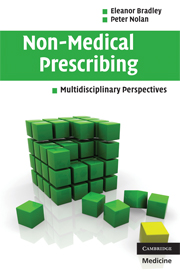Book contents
- Frontmatter
- Contents
- List of contributors
- Foreword
- Preface
- Acknowledgements
- Introduction
- 1 Medicines and prescribing – past and present
- 2 Nurse prescribing – impact, education and sustainability
- 3 Nurse prescribers: from 2003 to 2006
- 4 Nurse prescribing experienced
- 5 Nurse prescribing observed
- 6 Pharmacists and prescribing
- 7 Professions allied to medicine and prescribing
- 8 Conclusions
- Index
- References
1 - Medicines and prescribing – past and present
Published online by Cambridge University Press: 22 August 2009
- Frontmatter
- Contents
- List of contributors
- Foreword
- Preface
- Acknowledgements
- Introduction
- 1 Medicines and prescribing – past and present
- 2 Nurse prescribing – impact, education and sustainability
- 3 Nurse prescribers: from 2003 to 2006
- 4 Nurse prescribing experienced
- 5 Nurse prescribing observed
- 6 Pharmacists and prescribing
- 7 Professions allied to medicine and prescribing
- 8 Conclusions
- Index
- References
Summary
Wherever human communities have existed, strong evidence suggests that they used an assortment of medicines for alleviating suffering and promoting health (Wear, 1992). Healthcare in the past was closely aligned to the environment in which people lived, and being close to nature contributed to the health and well-being of individuals as well as the prosperity and survival of the tribe. Medicines were dispensed and administered by healers and shamans, who were revered for their skills in combating the malevolent forces thought to cause disease (Sonnedecker, 1976). Their medicines, often referred to as ‘nostrums’ (Latin nostrum remedium, meaning ‘our remedy’), were developed from a profound knowledge of plants, herbs and minerals. Healers strove to keep the constituents of their medicines secret from other tribes and healers. To enhance their therapeutic potency, medicines had to be administered under special conditions that might relate to the time of day or phase of the moon and, in addition, were usually accompanied by elaborate rituals, incantations and prayers. In various forms, natural remedies have doubtless brought comfort to countless millions over the centuries, and people have continued to believe in them despite the fact that they have sometimes proved disappointing or even lethal in their effects (Parish 1980). Today it is known that a number of factors beyond the constituents of the medicinal compound itself contribute to the benefit derived from them; these factors include being clear about what the problem is, trusting the person who prescribes the treatment and abiding by whatever regimens or lifestyle changes are recommended in order to restore and promote health.
- Type
- Chapter
- Information
- Non-Medical PrescribingMultidisciplinary Perspectives, pp. 9 - 34Publisher: Cambridge University PressPrint publication year: 2008



